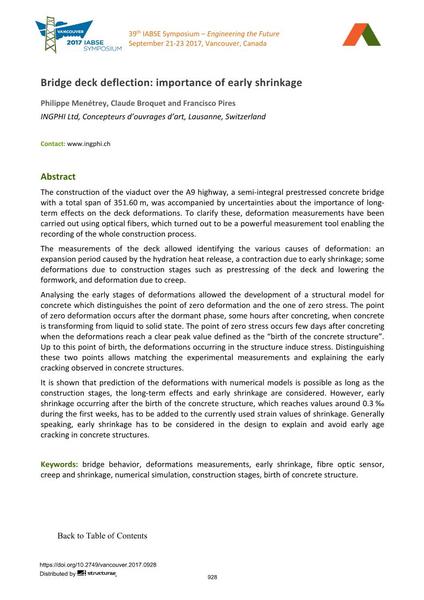Bridge deck deflection: importance of early shrinkage

|
|
|||||||||||
Bibliographic Details
| Author(s): |
Philippe Menétrey
(INGPHI Ltd, Concepteurs d’ouvrages d’art, Lausanne, Switzerland)
Claude Broquet (INGPHI Ltd, Concepteurs d’ouvrages d’art, Lausanne, Switzerland) Francisco Pires (INGPHI Ltd, Concepteurs d’ouvrages d’art, Lausanne, Switzerland) |
||||
|---|---|---|---|---|---|
| Medium: | conference paper | ||||
| Language(s): | English | ||||
| Conference: | IABSE Symposium: Engineering the Future, Vancouver, Canada, 21-23 September 2017 | ||||
| Published in: | IABSE Symposium Vancouver 2017 | ||||
|
|||||
| Page(s): | 928-935 | ||||
| Total no. of pages: | 8 | ||||
| Year: | 2017 | ||||
| DOI: | 10.2749/vancouver.2017.0928 | ||||
| Abstract: |
The construction of the viaduct over the A9 highway, a semi-integral prestressed concrete bridge with a total span of 351.60 m, was accompanied by uncertainties about the importance of long- term effects on the deck deformations. To clarify these, deformation measurements have been carried out using optical fibers, which turned out to be a powerful measurement tool enabling the recording of the whole construction process. The measurements of the deck allowed identifying the various causes of deformation: an expansion period caused by the hydration heat release, a contraction due to early shrinkage; some deformations due to construction stages such as prestressing of the deck and lowering the formwork, and deformation due to creep. Analysing the early stages of deformations allowed the development of a structural model for concrete which distinguishes the point of zero deformation and the one of zero stress. The point of zero deformation occurs after the dormant phase, some hours after concreting, when concrete is transforming from liquid to solid state. The point of zero stress occurs few days after concreting when the deformations reach a clear peak value defined as the “birth of the concrete structure”. Up to this point of birth, the deformations occurring in the structure induce stress. Distinguishing these two points allows matching the experimental measurements and explaining the early cracking observed in concrete structures. It is shown that prediction of the deformations with numerical models is possible as long as the construction stages, the long-term effects and early shrinkage are considered. However, early shrinkage occurring after the birth of the concrete structure, which reaches values around 0.3 ‰ during the first weeks, has to be added to the currently used strain values of shrinkage. Generally speaking, early shrinkage has to be considered in the design to explain and avoid early age cracking in concrete structures. |
||||
| Keywords: |
numerical simulation creep and shrinkage construction stages bridge behavior deformations measurements early shrinkage fibre optic sensor birth of concrete structure
|
||||
